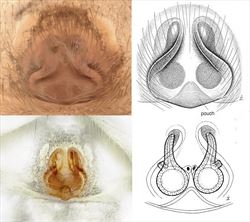
Examples of live Helpis
Illustrator (and ©) R. Whyte

Aspects of the general morphology of Helpis
Illustrators (and ©) B.J. Richardson (CSIRO), M. Zabka (diag.) (QMB)

Palp morphology of Helpis
Illustrators (and ©) R, Whyte (L), B.J. Richardson (M) (CSIRO), M. Zabka (diag.) (QMB)

Epigyne morphology of Helpis
Illustrators (and ©) B.J. Richardson (TL) (CSIRO), R. Whyte (BL), M. Zabka (diag.) (QMB)
Helpis Simon, 1901
Taxonomy
Helpis has thirteen Australian species, Helpis colemani, H. foelixi, H. gracilis, H. kenilworthi, H. longipalpis, H. merriwa, H. minutabunda, H. occidentalis, H. risdonica, H. stargai, H. tasmanica, H. wanlessi and H. wisharti. The genus is part of an Australasian clade (Maddison et al 2008) including Adoxotoma, Arasia, Astia, Astilodes, Jacksonoides, Megaloastia, Parahelpis, Sondra and Tauala. Genera from Indonesia (Katya) and the Philippines (Orthrus) may also be part of this group (Maddison 2015). Further information on the genus and described species can be found in Richardson and Żabka (2017) and Whyte and Anderson (2017).
Description
Helpis spp. are medium-sized spiders, length 4 to 9 mm, with an elongate-ovate abdomen. The head, viewed from above, is rather pear-shaped with a gentle posterior slope. The eye field widens posteriorly and there is often a transverse fringe above the anterior eyes. Paturons (bases of the chelicerae) are inclined forward with multiple (plurident) retromarginal teeth and several promarginal teeth. The legs are slender and as long as, or longer than, the body. The first or fourth pair of legs is longest.
The male’s palp and female’s epigyne differ between species. The male’s palp has a cymbial flange and the tegulum is ovoid, with or without a tegular lobe. The embolus is usually bent or hook-like with a broad base. A single retro-lateral tibial apophysis is slightly bent or hooked.
The epigyne usually has a large posterior pouch and a caudal lobe and two atria with median guides. Insemination ducts move posteriorly to the round spermathecae.
Biology
Helpis spp. have been collected on the ground, under rocks, under bark and on foliage. They are found in a very wide range of environments, ranging from rainforest to heathland, woodland and alpine moors and occasionally in houses.
Distribution
Helpis spp. have been recorded from the wetter parts of the country from Tasmania to the Kimberley region and are also present in New Guinea and New Zealand.
References
Gardzinska, J. 1996. New species and records of Astieae (Araneae: Salticidae) from Australia and Papua New Guinea. Memoirs of the Queensland Museum 39, 297-305.
Gardzińska, J. & Żabka, M. 2010. A new genus and five new species of Astieae (Araneae: Salticidae) from Australia, with remarks on distribution. Zootaxa 2526, 37-53.
Harland, D.P., Jackson, R.R. & Macnab, A.M. 1999. Distances at which jumping spiders (Araneae: Salticidae) distinguish between prey and conspecific rivals. Journal of Zoology, London 247, 357-364.
Hawkeswood, T.J. 2003. Spiders of Australia: An introduction to their Classification, Biology and Distribution. Sofia : Pensoft 263 pp.
Hogg, H.R. 1900. A contribution to our knowledge of the spiders of Victoria; including some new species and genera. Proceedings of the Royal Society of Victoria 13, 68-123.
Jackson, R.R. 1987. Comparative study of releaser pheromones associated with the silk of jumping spiders (Araneae, Salticidae). New Zealand Journal of Zoology 14, 1-10.
Maddison, W.P. 2015. A phylogenetic classification of jumping spiders (Araneae: Salticidae). Journal of Arachnology 43, 231-292.
Maddison, W.P., Bodner, M.R. & Needham, K.M. 2008. Salticid spider phylogeny revisited, with the discovery of a large Australian clade (Araneae: Salticidae). Zootaxa 1893, 49-64.
Richardson, B.J. & Żabka, M. 2016. Salticidae. Arachnida: Araneomorphae. Canberra, Australian Faunal Directory. Australian Biological Resources Study, at https://biodiversity.org.au/afd/taxa/SALTICIDAE.
Wanless, F.R. 1988. A revision of the spider group Astieae in the Australian Region. New Zealand Journal of Zoology 15, 81-172.
Whyte, R. & Anderson, G. 2017. A Field Guide to Spiders of Australia. CSIRO Publishing: Clayton.
Zabka, M. 1990. Remarks on Salticidae (Araneae) of Australia. Acta Zoologica Fennica 190, 415-418.
Zabka, M. & Patoleta, B.M. 2014. New species of Helpis Simon, 1901 from Australia (Araneae: Salticidae), with a new definition of the genus. Zootaxa 3873, 571-589.
* The information sheet should be interpreted in the context of the associated diagrams and photographs. Diagrams explaining anatomical terms can be found in the ‘Salticidae’ pictures at the beginning of the list of genera.